The year 2020 was a year of a global lockdown, with traveling reduced to a minimum. But it was also a year when an unstoppable Canadian made a journey of his lifetime. Bert terHart (62) became the ninth person who succeeded in sailing around the world alone, using only celestial navigation!
Bert terHart is the ninth person who managed to circumnavigate the world in a solo non-stop trip, using only traditional navigational tools
While the COVID-19 pandemic shut down world economies and quarantined entire countries, this man was writing history, experiencing a quite different form of self-isolation. Rocked by the rough ocean waves, with no continent in sight, it was a definition of social distancing. During the majority of his trip, the closest humans were the astronauts on the International Space Station!
On October 26th, 2019, Bert terHart left Victoria on Vancouver Island, and rounded the five great southern capes (Cape Horn in Chile, Cape Agulhas in South Africa, Cape Leeuwin in Western Australia, South East Cape in Tasmania, and South Cape in New Zealand), before returning home on July 18th, 2020. For 267 days, he did not step on firm ground.
His solitary home was Seaburban, a family sailboat built in 1987. With the navigational help of a sextant, pen-and-paper, and log tables, the dangerous journey of sailing around the world luckily finished as an epic adventure story. Ber terHart is here to tell it!
For more lessons on the dangers of traveling, read about the riskiest situations from my journeys!
The journey worth the risk
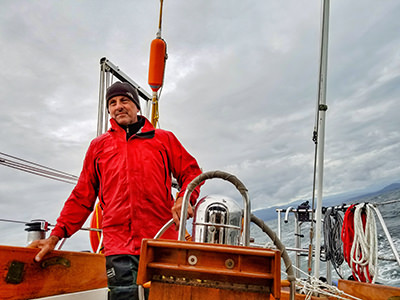
There are many ways to go around the world, and a bunch of them don’t require nine months like yours did. The same as when they see a person risking life to climb the highest mountains only to step on the top, many will see your extraordinary journey and ask: why?
The first question I’m usually asked is ‘why’. It’s also the most difficult to answer as there are a hundred of different whys each with its own rich context. For me, there were physical, emotional, mental, and spiritual whys I had in mind. There were interpersonal whys focused on motivating others. There were whys associated with doing something that would outlive me. Any of the ones I’ve mentioned could fill a book. And they probably will if I can’t pair down what I’ve been writing so far.
I think that one of the most interesting whys, is why did the trip resonate with so many people? What is it about someone pitting themselves against such a task that is so compelling for so many? That’s an interesting, nuanced question. It also, or at least I think it offers some insight into why that question is asked so often.
For the other sailors and mountaineers that I’ve spoken to, it’s not “only to step on the top”. Indeed, the top has very little to do with why they take the risks. The journey, the process is worth the risk. The top is simply a measure of where one journey starts and another begins. Similarly, for the adventurers I know, the top is not a bucket-list item to be checked off. It’s another way of saying ‘next’.
The most succinct why I can give you is this: Why not? To fill in the blanks, ask yourself why not choose to do something extraordinary? Or adventurous? Exploratory? Or transformative?
One Canadian family had very clear reasons for taking a trip around the world. They wanted to fill visual memories of their children losing their eyesight. Read our interview with Edith Lemay!
Bert terHart grew up with adventure
Tell us a bit about how you grew up! Did you develop an interest in early-world explorers in childhood?
I grew up on the Canadian prairies. My father taught me to sail on a small dam that was created to provide cooling water for a coal-fired power plant. Estevan and Boundary Dam are about as far removed from a solo, non-stop circumnavigation via the 5 great capes as one might imagine. Nonetheless, I learned to love sailing, science, and adventure in equal measure there.
I also gained an appreciation of the early explorers and surveyors that trekked sea to sea to sea across the great plains, mountain ranges, and vast wilderness that much of Canada is today. That appreciation blossomed when I came to live on the west coast of Canada where the wake and footsteps of Cook, Bligh, Vancouver, MacKenzie, LaPerouse, Thompson, and Bodega y Quadra, just to name a few, can be seen and found to this day. They are, in fact, right outside my front door. Their experiences, shared or otherwise, have fascinated me for decades.
Itinerary at the mercy of the weather
What were your itinerary goals and navigational plans when you left Victoria, Canada, your home, and replaced it with a sailboat?
An attempt to sail around the world leaving from the north-west coast of the Americas is bounded by the tropical storms and hurricanes spawned off the west coast of Mexico in the summer and fall months in the Northern Hemisphere and the weather you can expect to face in the Southern Ocean. More specifically, it would be suicidal to try and sail a small boat through a hurricane in the tropical eastern Pacific or around Cape Horn in the dead of a Southern Hemisphere winter. That translates into leaving the northwest coast of America no earlier than September and no later than November.
Once you set a date between September and November and leave on that date, the rest of the trip is pretty much cast in stone. The boat will only go so fast and the weather, outside of what is known by climatological means, will be what it will be. I had hoped to:
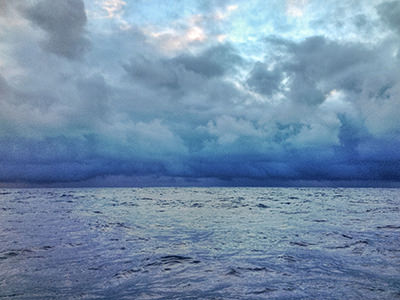
1. Leave by the 1st of October 2019
2. Clear Cape Horn at the beginning of December
3. Clear Cape Agulhas at the beginning of January
4. Clear Cape Leeuwin mid to late February
5. Clear South East Cape at the beginning of March
6. Clear South Cape mid-March
7. Return mid-May 2020
Sailing around the world – a true solitude
In reality, I assume there is no such thing as a “solo journey around the world”. Who were the people supporting you and how?
I would disagree with this. It is hard to articulate, let alone imagine just how alien and remote most of the world’s oceans are. This is especially true in the Southern Ocean. It’s one thing to say ‘thousands of miles from the land’, or ‘the nearest person to me was on the International Space Station’, or perhaps ‘it’ll take me 6 weeks to get to shore’ and something completely and utterly different to live it entirely and utterly alone.
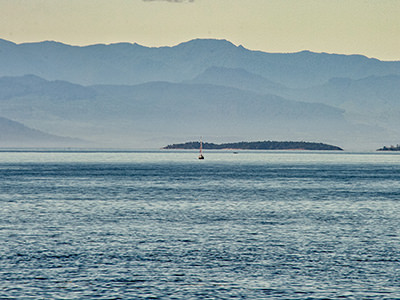
There is no one and no thing that can help, do, decide, or make you do anything no matter how big or small, no matter how trivial or life-threatening, other than you. It is impossible for anyone, save a minuscule few who have done a very similar thing, to have an understanding of how alone you are.
Of course, there are people genuinely concerned for your safety and well-being. And people supportive of your efforts. But that support can never be conflated with them being there and somewhere rendering the trip something other than solo.
Solitude is a challenge that Tom Turcich also faced on his adventure around the world - he circumnavigated it on foot, becoming the tenth person ever to do so!
Navigating between tradition and technology
We could count people who managed to encircle the globe via the five great southern capes, without stopping and without GPS, on two hands. Did you say goodbye to all technology?
I am the ninth person to circumnavigate, solo, non-stop around the world using only traditional navigational tools. The first two did it as part of the original Golden Globe Race (1969). The third was Chay Blyth (1971) who incidentally sailed against the prevailing winds and therefore the ‘wrong way’ around. The next 5 did it as part of the reincarnation of the Golden Globe Race (2018). I am the ninth, the first North or South American, and the first to do so leaving from the West Coast.
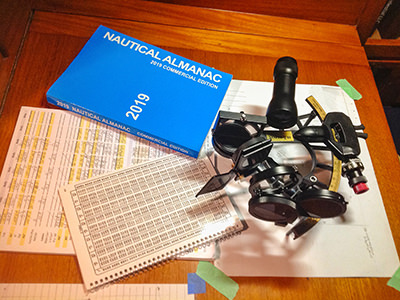
Traditional navigational tools imply a sextant, tables, pencil, paper, and a watch. I used no electronic navigational tools or aids. No calculators, no GPS, no SatNav, Loran, or anything of the kind.
I used non-traditional technology for communications including single side-band (SSB) and VHF radio, Automatic Identification System (AIS) to warn other vessels of my presence, and an Iridium GO! satellite link for email and limited voice communications. I used a laptop connected to either the SSB or the Iridium GO! to receive weather forecasts.
50 shades of rough
How did the weather serve you? It must have been rough at times?
I served at the mercy of the weather always. Calm or storm, I was enslaved to the weather as any sailboat would be. Rough is relative. Rough in the Strait of Georgia or the North Pacific doesn’t begin to compare to rough in the Southern Ocean.
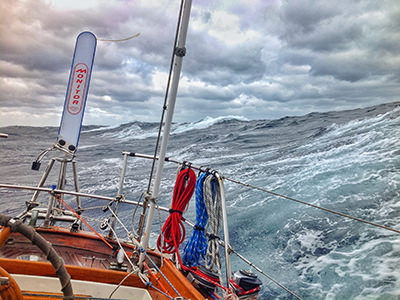
The only way to sleep for the majority of the trip was to strap myself down to my bunk. Even during calms, the motion of the boat is chaotic as the swell and waves persist long after the wind has evaporated. To work at the chart table required strapping myself down onto the seat at the navigation station. At sea on a small boat, it’s rough ALL the time.
Did you ever question your decision on making this expedition?
No. Once you’ve committed to going, there is precious little room if any at all for second-guessing that decision. While at sea, there’s no room whatsoever for second-guesses. It is literally do or die. You would always be right, but to second-guess as opposed to acting is tantamount to disaster or worse.
You knew that the boat would possibly not survive. Was there ever a plan B?
I had a life raft and an Emergency Position Indicating Radio Beacon (EPIRB). Realistically, if the boat were to sink and I had to take to the raft and hope, the probability of surviving such an event is extremely low.
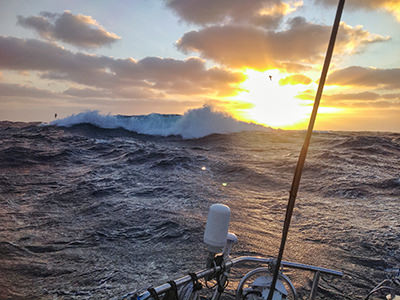
The most violent environment on Earth
Sailing around the world is dangerous. Have you ever thought you might not make it?
My life was truly endangered the moment I entered the Southern Ocean and remained so until I left some four and one-half months later. It is the most extreme, most violent, most hostile environment on the planet. And that’s not including the most remote. Remote as in no reasonable chance of help or rescue.
The severe storms in the Southern Oceans are vast swaths of hurricane-force winds encompassing thousands of square miles of ocean with waves the size of 4 or 5-story apartment buildings. To say that my life was in danger is not hyperbole.
I never thought I wouldn’t make it. I did, however, worry constantly about keeping the boat in one piece. Like any machine, constant harsh use in extreme conditions takes a severe toll on everything. You have a very small window to get in and get out. Pushing that window means risking mechanical failures and breakdowns that can quickly cascade out of control.
The day of the injury
Injuring oneself on the boat, with nobody nearby to help, could be already nerve-racking as an idea. You had such a moment, but how did you overcome it and found the courage to continue?
Any injury, no matter how minor, is a recipe for disaster. A small cut, constantly exposed to salt water, can easily become infected, turn septic and result in an excruciating, lonely, ignoble end. I did everything I could to avoid injury. It was the biggest concern.
I turned around and let go. Crumpled, I laid in agony and unable to move. I had hurt my back but just how badly, I didn’t knowBert terHart
Avoiding injury requires constant vigilance and attention. Standing in the cockpit and hanging on with both hands to the safety bar that forms part of the main companionway dodger, I turned to look behind me and for some reason, let go. I was immediately tossed some 5 feet (1,5 m, Ed.) across the cockpit and folded in half backward over the stainless steel bars that protect the compass. Crumpled on the cockpit sole, I laid in agony and unable to move. I had hurt my back but just how badly, I didn’t know.
Fortunately, the weather was relatively mild and forecast to be that way for at least two days. I spent those days strapped to my bunk, barely able to deal with the minimum required to sail the boat even in those conditions. Anything not absolutely necessary was out of the question.
I don’t believe it was the courage to overcome. It was rather the simple necessity of continuing. Other than quitting and resigning one’s self to whatever the fates may hold, there’s nothing else to do but continue. I rested for those two days as best as I could and then set about sailing home.
Bert terHart, the luckiest man alive
You are 62 now. Some people of your age have trouble going up the staircase, not even imagining how it is having waves tossing you around the boat like a puppet while you are just trying to use the loo. I wanted to ask you about the secret of your fitness, but then I’ve also read that you broke your ribs three weeks before this odyssey! You really have guts!
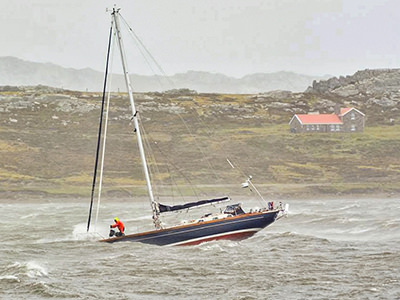
I ended up leaving at the end of October as opposed to the beginning as I had fallen off the mast in mid-September. That fall resulted in 4 fractured ribs and a collapsed lung. No one expects to survive a 55’ fall (almost 17-meter height, Ed.), let alone walk away from it. I don’t know how I survived. I was air-lifted by helicopter to the nearest trauma center equipped to deal with someone who has massive internal injuries. The doctor that saw me into the helicopter was not convinced I would survive the flight.
The head of the surgical team that admitted me said on my release that the smartest thing I could do at that moment was buying a lottery ticket. He figured I was the luckiest guy alive and certainly one of the luckiest patients he had ever seen. I limped out of the emergency room using my father’s cane 40 minutes after arriving.
I don’t have any fitness secrets. Other than rugby and Tae Kwon Do (I’m a third-degree black belt), I don’t do anything too different than I’ve always done.
Age is just a number, claim two Texas ladies that traveled around the world in 80 days at age 81. Meet TikTok Traveling Grannies!
Dangers of sleep deprivation
Traveling without a companion is not only about social distancing. It’s also about not being able to share responsibilities with anyone. How did you decide that it was safe for you to sleep, for instance?
Everything you do is done so as to optimize something. Whether it’s the direction you’re going, the weather you’re trying to avoid or catch up, how fast you could or should be going, when it’s OK to eat, to navigate, or to sleep. When it’s not safe to do it, you don’t. You simply don’t have a choice.
If it is safe to do something, or you think it will be safe sometime in the future, then that’s what you do. In some ways, you live a very regimented life. It just so happens that you’re not the one regimenting.
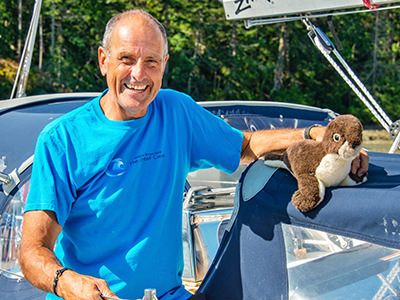
Being alone at sea for a long time can bring a person to a state where reality and fantasy mix. As suggested in the “Life of Pi”, one can even start talking to tigers and discovering phantasmagorical islands… Have you traveled to any of those hallucinatory places?
The only sailors I know of who have hallucinated as you describe are those that have been injured, were sick, or were seriously sleep-deprived. Hallucinations are not at all uncommon to survivors of extreme events and there are numerous stories of sailors (Joshua Slocum after a bout of food poisoning) and mountaineers (Jeff Beck surviving on Everest after having been given up for dead at least twice) coming to mind.
Being alone at sea I believe is neither necessary nor sufficient. A serious injury or ailment would be sufficient. I was never in that state so, happily, I was able to keep my wits!
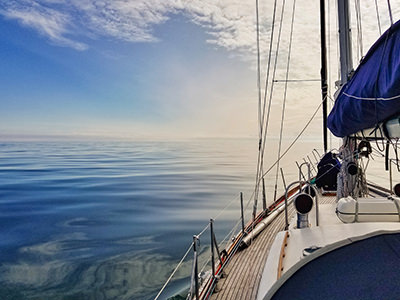
The ocean as a spiritual desert
I hope you do not mind me asking, but are you yourself religious? People go to the solitude of monasteries, to deserts and mountains, to talk directly to God. Piscine Patel from Yann Martel’s novel went through a peculiar spiritual journey too. Did your view of religion change in any way after this trip?
I am religious in that I would argue that there is something far greater than me in this universe. What that is, I am unsure. I am sure, however, that it is everywhere and all around us. I am continually amazed and astounded by the natural beauty and wonder that exists everywhere we choose to look.
Yet, in no way did I embark on my circumnavigation in the hopes of finding God. You could make a very good argument that such a journey is in fact an abdication of your responsibilities, perhaps even your duty, as a human.
That said, alone, thousands of miles from land and help, with nothing between you and the universe save for your wits and a bit of plastic, it is impossible to ignore that which is greater than one’s self.
Where have all the whales gone?
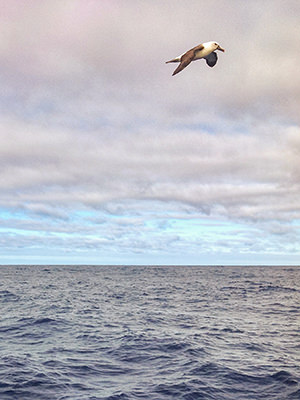
Which animals did you encounter?
My encounters with marine mammals were extremely rare and far less than I expected. Encounters with dolphins and porpoises are very common and on my other trips, they’re almost a daily occurrence. Not so on my circumnavigation. Whale encounters, while less frequent, can also be expected. When traveling in the Northeastern Pacific and the Gulf of Alaska, encounters with Humpback, Blue, Killer, Gray, and Minke whales are normal. I was shocked and disappointed that on only one occasion did any whale come near the boat. Similarly, I saw no evidence of them as spouts or breaches.
Would you have an interpretation for that?
Why that is, I can only speculate. I can say that the industrialized commercial fishing fleet is alive and well on the high seas. The population of pelagic seabirds, especially Albatross, has been decimated by a drastic reduction in food supplies by commercial fisheries. I can well imagine that similar industrialized fishing pressure throughout the food chain has resulted in reduced populations of marine mammals and other species that occupy the top tiers of those ecosystems.
If you want to see the whales in their natural habitat, check our experience during the Tenerife whale watching trip!
Regarding the constant entertainment afforded by those species of birds that spend the vast majority of their lives on the open ocean, the Albatross reigns supreme. There are many species of Albatross scattered all over the globe, but the one species that symbolizes all that the Southern Ocean is to sailors is the Wandering Albatross. It is huge, curious, almost friendly, and a wonder. The smaller species, like the Black-Browed Albatross, were more frequent visitors but no less majestic. Of all the birds that accompanied me around the world, the one that captured my attention was the smallest of them all, Wilson’s Stormy Petrel. They are, in fact, the smallest warm-blooded creature to breed in the Antarctic and one of the most numerous bird species in the world. They were with me through every kind of weather imaginable.
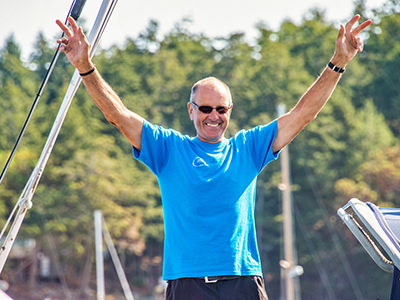
Yes we can
Were sea fish your source of protein, or you mainly lived from canned food? How did you deal with food rationing?
I caught no fish. The open ocean is like a vast desert, as most fish, especially those that one person can reasonably eat, are limited to coastal waters and the tropics.
Double-smoked sausage lasts an extraordinarily long time if cared for and canned tuna, salmon, chicken, and ham last indefinitely as long as the cans remain dry.
I rationed food the minute I left the dock. In that regard, I was extremely disciplined and rarely wavered. I had calculated how much food I needed and had provisions on board for more than eight months. Unfortunately, I made a very serious, very basic error.
On other trips, my appetite had waned. I based my caloric intake on my normal diet thinking that, like on my other trips at sea, my appetite would reduce. Thus, my nearly nine months of provisions would be ample with lots to spare.
It turned out that my appetite was huge and I was eating fully twice as much as was normal. 9 months of provisions divided by two makes 4 ½. I very quickly realized I was going to run out of food if I didn’t drastically reduce my rations. As a result, I was down to less than 800 calories a day. At 800/day, I would have enough to complete the trip albeit the last month or so would be rice and oats only.
The beauty and the beast of the ocean
Besides an extreme physical feat, this also had to be a really emotional journey. What were your highs and lows?
The lows were definitely being becalmed. I was becalmed for more than 50 days. Going nowhere, the boat slamming around, barely able to move around the boat all while mowing through precious food and water is emotionally, physically, and mentally challenging to say the least.
The highs have to be the evenings and early nights. The entire universe bursts into being in a way unlike anywhere else I’ve ever been. Moreover, it’s all for you. There is no one else there to see the show.
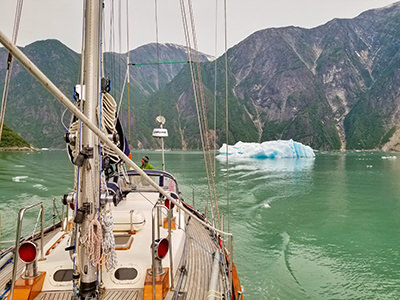
It certainly sounds like a privilege. Can you be more precise about what have you seen? I am aware we live in highly light-polluted societies, so being on such a boat could be an astronomer’s dream come true. Is that the main reason behind it?
The near-constant haze that hangs near the surface of the ocean obscures the night sky to some degree. There are occasions, however, when the haze clears off and the skies are otherworldly. It is only ‘pitch-dark’ when the cloud cover is thick and low. Otherwise, even on moonless nights, the visibility at night is remarkably good. When the moon is full and the skies are clear, it is astonishing how bright it is. You could read a newspaper by the light of the stars, planets, and moon.
The twilight hours, just after the sun has set, and the moon is yet to appear, were magical. There are only a few places on land that can come close to the vast expanse of the heavens that are on display for anyone willing to get on a boat and sail away from shore. The expanse alone is a thrill. Realizing that it is for you and you alone is humbling beyond words. Arrayed as it is, there is nowhere else anywhere on the Earth like it. As twilight fades and night falls, layer upon layer of splendor reveals until one is at an absolute loss for words.
What were the most beautiful aspects of your voyage?
This is not an easy question. What is beauty? What aspect of the voyage shall we talk about? I think witnessing how perfectly adapted to that vast wilderness of sea and sky the tiniest of creatures were, and how effortlessly they existed there, was a privilege afforded only a handful of humans. I would say there is something beautiful in that.
Social distancing at extreme
The pandemic happened and the world changed while you were away. The planet went into lockdown. Some protested against the limiting of their “freedom of movement”. Some get dramatic even if they need to self-isolate for 10 days! You’ve spent 267 days alone at the sea. Is there a lesson there you could share?
There is opportunity everywhere. It comes in all shapes and forms. In no way am I trying to diminish the suffering that Covid-19 has wrought. The lockdowns do represent an opportunity to reconnect with family and loved ones, to take the time to read important books, or to indulge in a hobby that you’ve missed or given up on. My own father took the lockdown as an opportunity to brush up on his Indonesian and Malayan.
Lockdown or not, we live in a country that still allows us to choose what we do and how we do it. I would say choose and if possible, choose wisely.
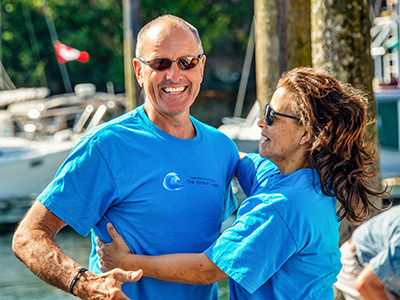
What things did you miss the most on this journey?
Beyond the obvious like my wife Nani, my children, and my family, I missed the simple things. The things you take for granted. Sitting down to eat. Putting a pencil down and finding it in the same place 10 seconds later. Dry socks.
After returning, you experienced a sort of stardom. How do you cope with it?
Universally, the feedback has been extraordinary. People are fascinated, curious, motivated, and inspired. The attention has been somewhat overwhelming but incredibly uplifting. I would argue that anything you may have heard, or perhaps believe, about the cynical nature of humankind is not just unwarranted, but flat-out wrong.
Bert terHart, the safest person in the world?
Paradoxically, embarking on this rather risky adventure earned you the title of “the safest man on the planet”. Pandemic aside, what is your view on the notion of playing safe in relation to still living life to the fullest?
Although at zero risk of getting the Coronavirus, I was in no way, shape, or form the safest man on the planet. The Shoreteam and I took a lot of flak, especially from the sailing community, about that. During the time I was in the Southern Ocean, I was perhaps the least safe person on the planet. I just couldn’t die from Covid-19. Everything else, however, was on the table.
In the Southern Ocean, I was perhaps the least safe person on the planet. But how many people die in their sleep every day? My time will come as it must. All I have is my nowBert terHart
There is no safe. Safe is an illusion. My friend, Glen Wakefield, is a testament to that (Editor’s note: Glen Wakefield died from a stroke while sailing solo to the southern tip of South America, in September 2020).
How many people die in their sleep every day? Or are killed walking across the road? Falling down the stairs? My time will come as it must. All I have is my now. What do you think I should do? How do you think that time is best spent?
Of course, there are risks. But there are rewards beyond our imaginations if we can put aside what we perceive the risks to be. I will tell you that one risks far more than I in seeking safe harbor.
If you don't find taking risks stimulating, check out which are the safest countries in the world for travel!
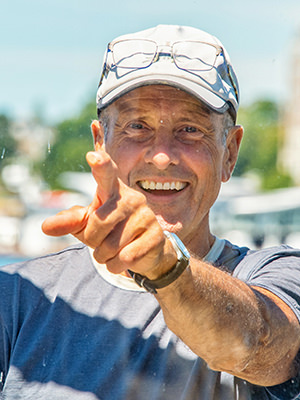
New adventures on the horizon
Was this your “Mount Everest”, or are you already dreaming of some new adventures?
Oh no. I have other adventures planned. All following the same thread: An attempt to discover something about our world and our shared experiences by following in the footsteps of the great adventurers and explorers who have shown us the way.
Are those adventures a secret?
I plan to sail back to the Aleutians next year and sometime shortly after that into the Eastern Arctic. If I can talk my wife into another cold-water adventure, we’ll hopefully head back down to Patagonia and beyond.
With respect to the first, I plan to walk across Canada in the footsteps of Alexander MacKenzie, David Thompson, Henry Kelsey, Jean Baptiste de la Verendrye, and Simon Fraser. By threading portions of their journeys together, I’ll be able to walk from coast to coast navigating only with a sextant, tables, pencil, paper, and a watch. The idea is to compile a then-and-now retrospection of their shared journeys and experiences in the exact places where they were.
Did you like Bert terHart’s adventure of sailing around the world?
Pin this interview for later!
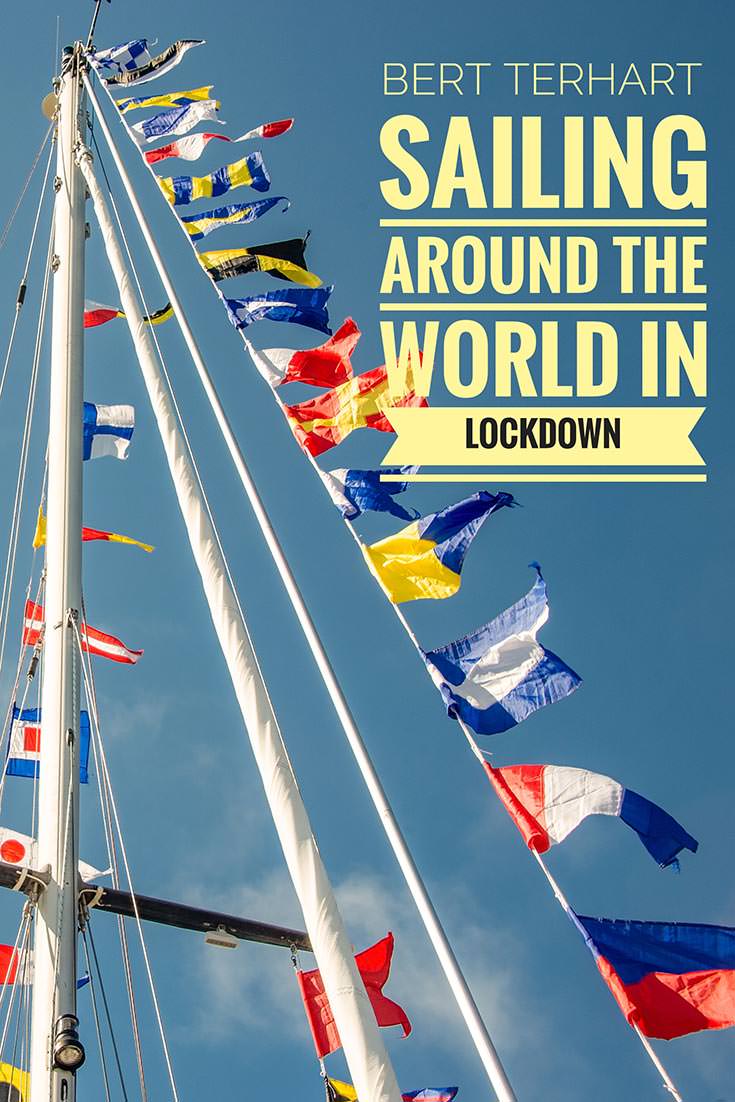

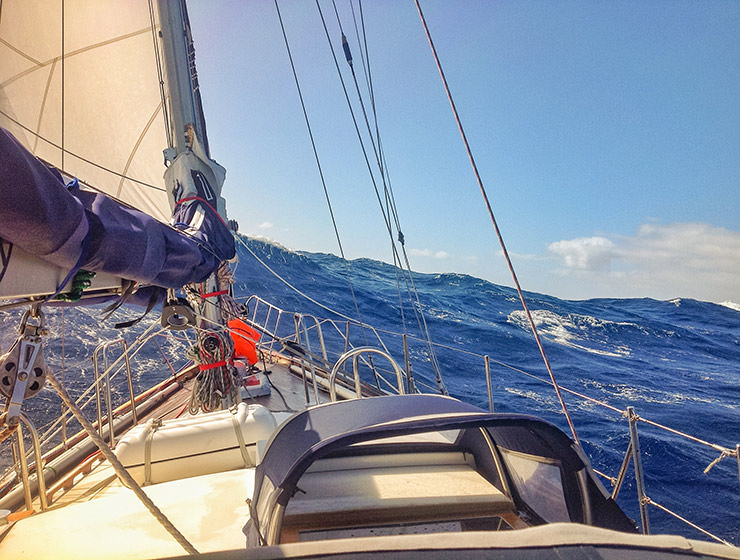

One of my long term goals is to buy a catamaran and sail the islands for a year and then head across the Paciffic. Just got to get my wife to agree.
Exciting idea, Chuck! Hopefully, she agrees!